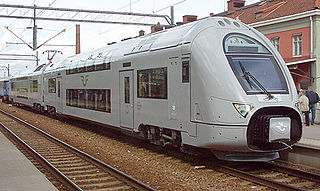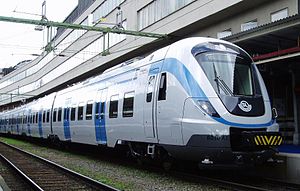
The Stockholm Metro is a rapid transit system in Stockholm, Sweden. The first line opened in 1950 as the first metro line in the Nordic countries, and today the system has 100 stations in use, of which 47 are underground and 53 above ground. There are three coloured lines, as shown on the metro maps, which form seven numbered routes with different termini. Routes numbered 17, 18 and 19, 13 and 14 and 10 and 11 all go through the centre of the city, resulting in a very centralized system. All three lines and seven routes interchange at T-Centralen station. Apart from this, there are three other interchange between lines, at Fridhemsplan, Slussen and Gamla stan stations.
Bombardier Transportation was a Canadian-German rolling stock and rail transport manufacturer, with headquarters in Berlin, Germany. It was one of the world's largest companies in the rail vehicle and equipment manufacturing and servicing industry. Bombardier Transportation had many regional offices, production and development facilities worldwide. It produced a wide range of products including passenger rail vehicles, locomotives, bogies, propulsion and controls. In February 2020, the company had 36,000 employees, and 63 manufacturing and engineering locations around the world. Formerly a division of Bombardier Inc., the company was acquired by French manufacturer Alstom on 29 January 2021.

The SNCF Class Z 26500 and Z 24500 are a series of electric multiple unit (EMU) trains with bi-level carriages, derived from the Coradia Duplex type of Alstom. They are also known as TER 2N NG from their use on regional TER services, bi-level design (2N), and, by replacing the SNCF Class Z 23500, status as a "new generation" (NG) model. The first order from SNCF, commissioned by the French regions, was launched in 2000, the last in 2009, for deliveries that lasted from 2004 to 2010.
Stockholm commuter rail is the commuter rail system in Stockholm County, Sweden. The system is an important part of the public transport in Stockholm, and is controlled by Storstockholms Lokaltrafik. The tracks are state-owned and administered by the Swedish Transport Administration, while the operation of the Stockholm commuter rail services itself has been contracted to SJ AB since March 2024.

Pågatågen is an interurban commuter and regional railway system in Skåne County, Sweden, and is owned by Skånetrafiken, the regional public transportation authority. The trains are operated by the contractor VR Sverige. The network has 72 stations, of which 9 are in the Malmö Urban Area: Malmö C, Triangeln, Hyllie, Svågertorp, Persborg, Rosengård, Östervärn, Burlöv and Oxie and 6 in the Helsingborg Urban Area: Helsingborg C, Maria, Påarp, Ramlösa, Rydebäck and Ödåkra.

The TGV Duplex is a French high-speed train of the TGV family, manufactured by Alstom, and operated by the French national railway company SNCF. They were the first TGV trainsets to use bi-level passenger carriages with a seating capacity of 508 passengers, increasing capacity on busy high-speed lines. While the TGV Duplex started as a small component of the TGV fleet, it has become one of the system's workhorses.

The Alstom Coradia LINT is an articulated railcar of the Alstom Coradia family manufactured by Alstom since 1999, offered in diesel and hydrogen fuel models. The acronym LINT is short for the German "leichter innovativer Nahverkehrstriebwagen". It was designed by Linke-Hofmann-Busch and has been distributed as part of Alstom's Coradia family.

The Rhine-Ruhr S-Bahn is a polycentric and electrically driven S-bahn network covering the Rhine-Ruhr Metropolitan Region in the German federated state of North Rhine-Westphalia. This includes most of the Ruhr, the Berg cities of Wuppertal and Solingen and parts of the Rhineland. The easternmost city within the S-Bahn Rhine-Ruhr network is Unna, the westernmost city served is Mönchengladbach.

The Alstom Coradia is a family of diesel and electric multiple units for intercity and regional service manufactured by Alstom, with variants operating in Europe, North America, and Africa.

X1 was a series of two-car electric multiple units operated by Greater Stockholm Transport (SL) on the Stockholm commuter rail. The X1 was operated in sets of up to five units, making ten-car trains, each unit consisting of one motor car and one unpowered car. 104 units were built by ASEA in 1967–75 and were replaced by the new X60. The X1 also served as the foundation for the later X10–X14 series trains, built in the 1980s and 1990s.

X10 is a series of two-car electric multiple units which was formerly operated by Greater Stockholm Transport (SL) on the Stockholm commuter rail between 1983 and 2017, when the City Line project made them imcompatible with the X60 train sets. The X10 was operated in sets of up to five units, making ten-car trains, each unit consisting of one motor car and one unpowered car. They were completely compatible with the X1 introduced in the 1960s. 101 units were built by ASEA between 1982 and 1993.

The X40 is a series of electric multiple units operated by SJ of Sweden. They are in service from Stockholm to Linköping, Västerås/Örebro, Uppsala and Gävle/Sandviken, and since 2010 to Gothenburg via Västerås. The double decker trains were built by Alstom from 2004–2008, with 43 units being delivered, either in a two-car or three-car configuration. It is based on the Coradia series, very similar to the French SNCF Class Z 26500 double decker trains, and similar to the X60-series.

Stadler FLIRT is a passenger multiple unit trainset made by Stadler Rail of Switzerland. The baseline design of FLIRT is an electric multiple unit articulated trainset that can come in units of two to twelve cars with two to six motorized axles. The maximum speed is 200 km/h (125 mph). Standard floor height is 57 cm, but 78 cm high floors are also available for platform heights of 76 cm.

The Alstom Metropolis C830C is the second generation of communication-based train control (CBTC) electric multiple unit rolling stock in operation on the Circle line of Singapore's Mass Rapid Transit (MRT) system. 24 trainsets of 3 cars were manufactured by Shanghai Alstom Transport Co Ltd, with deliveries from end June 2014.

The Train Express Regional (TER) is an airport rail link in Senegal that connects Dakar with Diamniadio and the Blaise Diagne International Airport.
The Meerut Metro is an under-construction rapid transit system, which will serve the city of Meerut, Uttar Pradesh, India. It is being built in two phases, of which the first phase with the first line will cover 23.6 km (14.7 mi) with 13 stations, from Modipuram to Meerut South. It will have nine elevated, three underground stations, one at-grade station as the depot station at Modipuram, and four stations integrated with the Delhi–Meerut Regional Rapid Transit System on a single corridor, making the metro the first such rapid transit system in India to be merged directly with a regional transit system. The second phase will include a second line covering 15 km (9.3 mi) from Shradhapuri Phase-II to Jagrati Vihar, with 12 stations, out of which seven will be elevated and five will be underground, thereby taking the overall length to 38.6 km (24.0 mi). The metro will also be the fastest metro of India, at an operational speed of 120 km/h (75 mph).

The MI 09 is a double-deck, dual-voltage electric multiple unit trainset that is operated on line A of the Réseau Express Régional (RER), a hybrid suburban commuter and rapid transit system serving Paris and its Île-de-France suburbs.

X61 is the name of the Alstom Coradia Nordic railcar which was ordered by Skånetrafiken, the regional public transport organisation in Scania (Sweden), operate 99 X61 trainsets, of which the first batch of 49 trainsets were delivered 2009–2011. An additional 20 trainsets was ordered in 2011 and in 2017 further 30 trainsets was ordered. The X61 is based on the SL X60, but with four cars per set instead of six and a total length of 75 m (246 ft), and are operated both as single trainsets and as longer trains made up of two connected four-car trainsets. The interior of the X61 is better suited for the often longer distances covered by regional trains, with toilets and more comfortable seats. Östgötatrafiken has bought 5 trains of type X61, delivered in 2010, and has ordered eight more, which was delivered 2015. Västtrafik has bought 22 X61 trains.

RER NG is a double-deck, dual-voltage electric multiple unit trainset that is currently under construction. Also known as the Class Z 58000 and Class Z 58500, the trainsets are expected to operate on line D and line E of the Réseau Express Régional (RER), a hybrid suburban commuter and rapid transit system serving Paris and its Île-de-France suburbs.

The MI 79, also known as the Class Z 8100 is a dual-voltage electric multiple unit trainset that is operated on line B of the Réseau Express Régional (RER), a hybrid suburban commuter and rapid transit system serving Paris and its suburbs. The MI 79, designed in the 1970s for the RER B which needed dual-voltage (interconnection) trainsets. They were followed by a derivative version, the MI 84, designed in the 1980s to meet the needs of the RER A line, before reassigned to the RER B in the 2010s.





















